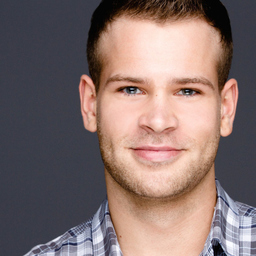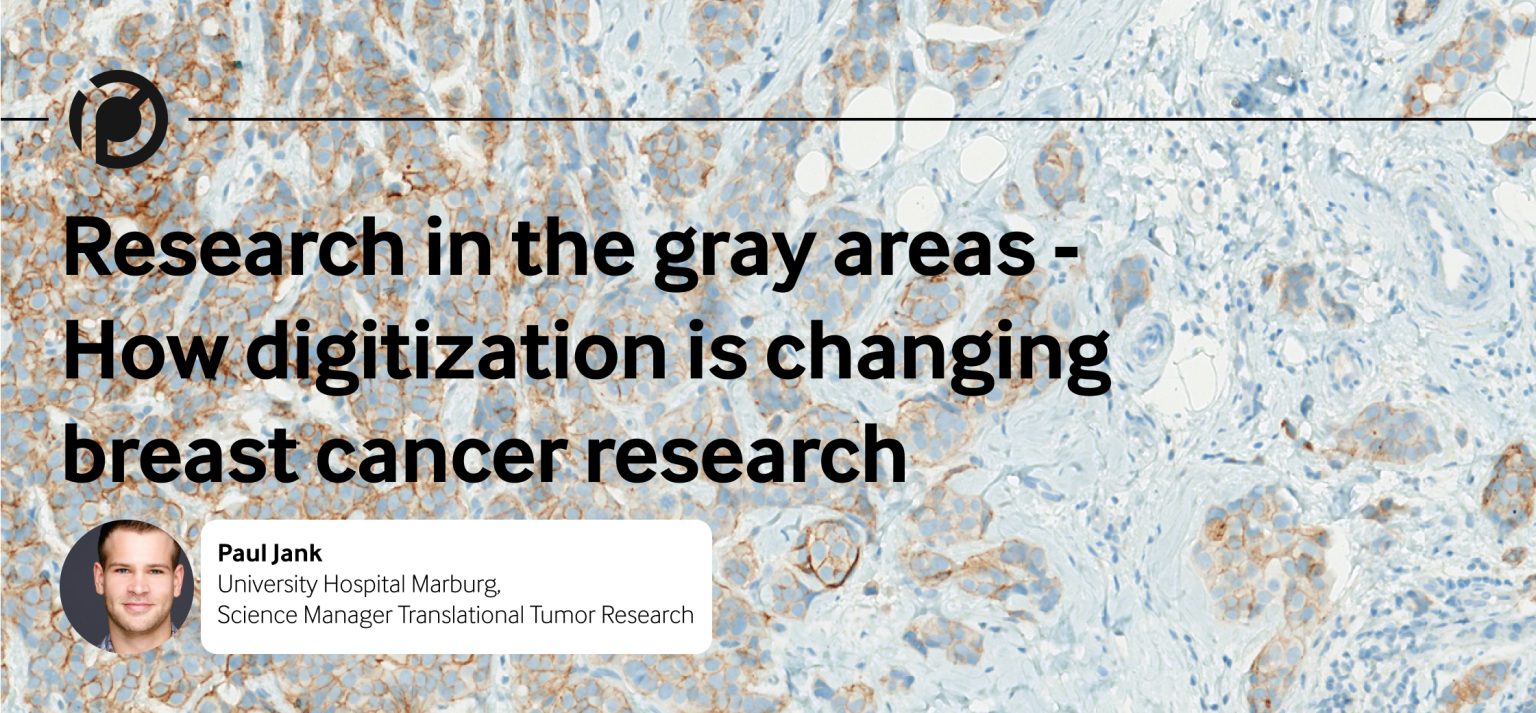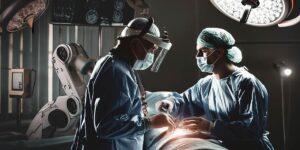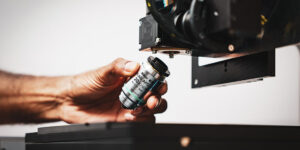Synopsis
Breast cancer is by far the most common disease among women in Germany and worldwide. That’s why every October for the last 36 years, the Breast Cancer Awareness Month has been drawing attention to prevention, treatment, and research. We spoke with Paul Jank. He is a scientist and biotechnologist at the Institute of Pathology at Philipps University in Marburg, Germany. Not only is the largest German biobank for breast carcinoma located in Marburg, important aspects of the disease are also researched there – always in search of even more individualized therapeutic approaches.
You work as scientist for Translational Tumor Research at Philipps University Marburg. What exactly are your tasks?
Paul Jank: My work is very interdisciplinary. I am a biotechnologist and soon to be healthcare professional. Here in Marburg, I am the laboratory manager of the central pathological and histological research laboratories. In addition, I am responsible for coordinating research at the institute, especially for breast carcinoma. I take care of the infrastructure, the personnel, the financial procurement and, where necessary, help to organize IT tools and services. Sometimes I am a service provider for my colleagues, sometimes I do scientific work myself. I coordinate research projects and help the research partners to find out which data, biomaterials, and methods they can work with to test their hypotheses.
How do you approach data in your research questions?
Paul Jank: You have to ask yourself what kind of material you need to answer your questions. Do you answer it in silico, that is, with data that already exist and are simulated on the computer? Do you use public databases or do you need additional samples and biomaterials? We have access to the tumor bank of the German Breast Group, where, for example, material from almost 50,000 patients with breast carcinomas from clinical studies is stored. New biomaterial is added every day, which means that currently up to 100 new slides are produced and added every day.

By loading the video, you agree to YouTube's privacy policy.
Learn more
University of Marburg's Breast Cancer Focus
For years, the University of Marburg has dedicated itself specifically to the topic of breast cancer. Since 2003, it has had the Regio Breast Center, which has been certified by the German Cancer Society and the German Society for Senology. Can you explain to us what this involvement looks like exactly? Paul Jank: The certification confirms a certain quality standard, which we offer. We not only accompany patients therapeutically and diagnostically, but also channel some of them into clinical studies. Of course, treatment and research at the Breast Center goes beyond the guidelines. We work on an interdisciplinary basis, and it is really exciting to see what happens when an interdisciplinary tumor board meets to work together on basic research. These different perspectives and approaches lead to completely new insights and approaches. The Comprehensive Cancer Center Marburg is linked to the UTC Frankfurt-Marburg. Diagnoses from the past 15 years are located there. It will be an exciting task to digitize all of these, enter them into the registry, and compare them with where the affected patients are today.
Stay Ahead with Insights from Precipoint!
Welcome to our newsletter! Be the first to know about our latest products, services, webinars, and happenings in PreciPoint. Don't miss out on this opportunity to stay informed. Subscribe to our newsletter today!
By clicking “Subscribe”, you agree to our privacy policy.
The University of Marburg is part of a large research network. What are the goals and benefits of this network and your involvement?
Paul Jank: Our association with the German Breast Group (GBG) serves clinical and academic research. The GBG is an academic research organization that has been conducting active clinical trials for breast cancer worldwide, for over 40 years now. The aim is to continuously improve breast cancer treatment and raise the quality of therapy. For more than 10 years, the GBG tumor bank has been under the direction of Prof. Dr. Denkert. In addition, we perform central pathological examinations mainly for inclusion in clinical trials. Biomaterials from over 55,000 patients that includes annotations, therapy, outcome, and follow-up data, enable us to answer current hypotheses in translational and biomarker research. In association with GBG but also beyond, we participate in national as well as international calls and initiatives for translational medicine, medical technology, precision oncology, and artificial intelligence.
Under the leadership of Prof. Dr. Carsten Denkert, Philipps University is participating in the EU-funded project BIGPICTURE - Central Repository for Digital Pathology. Can you explain what this is all about?
Paul Jank: Basically, it’s about harmonizing data. Simply put, academic partners from all over Europe and representatives from the pharmaceutical industry are trying to establish guidelines on how we harmonize data from digitized histology sections and their metadata. The goal is to create an archive of digital copies of about 3 million slides covering a range of disease areas. This will be the data basis for training neural networks. To do that, we first need to create the infrastructure to harmonize these millions of data. And, of course, we have to establish guidelines on how we manage to speak a uniform language. In addition, of course, data protection must be guaranteed.
You could say that networking is the key. Is it correct, that the possibilities are virtually endless if the data sets speak the same language?
Paul Jank: Yes, that’s exactly how it is. A good example here is the collaboration with GBG. There, about 100 parameters are defined per patient. The GBG has data on the progress of patients, which, depending on the study, can be tracked back up to 15 years. These data have always been recorded in the same format for ten years. The variables are coded. This makes it possible to ask completely new and different questions. Ultimately, I also think that networking is the task of research: New disciplines must be included, such as economists, lawyers, bioinformaticians. This will lead to completely new connections and outcomes.

You have a thesis, and the result is great, but at the same time it's a bit black and white. So you go back to the topic and deal with the gray areas. And that's also very important when you look at the number of women who get breast cancer every year.
Paul Jank, Science Manager und Biotechnologe am Institut für Pathologie, Philipps Universität Marburg.
What direction are you currently taking with your research at the University of Marburg?
Subclassifications of HER2 Expression in Breast Cancer
Paul Jank: One field of research is the subclassifications of the growth factor receptor HER2 negative, low positive and strong positive. HER2 is an important biomarker in breast cancer. Until now, targeted therapy with antibodies against this receptor was only promising if the tumor had a strongly increased concentration of HER2. That alone was a huge breakthrough. At the same time, it also shows very well how research works: You have a thesis, and the result is great, but at the same time it’s a bit black and white. So you go back to the topic and deal with the gray areas. And that’s also very important when you look at the number of women who get breast cancer every year.
Identification of HER2 Expression Subgroups and Response to Therapy
In this case, a nationwide research group led by the University Medical Center in Marburg and GBG found that there are HER2 expression subgroups that respond differently to anti-HER2 therapy. And this was a pure data analysis. They looked at data from over 2000 women who had received combination chemotherapy. It showed that in 48 percent of the tissue samples, there was a weak positive concentration of HER2 – a separate subtype of breast cancer.
Challenges in Triple-Negative Patients and Immune Checkpoint Inhibitors
Then there are those patients in whom there is no HER2 at all and no hormone receptors. Until now, these triple-negative patients could only be treated with chemotherapy, and often not successfully. Large studies on immune checkpoint inhibitors are currently underway.
The goal is always to find out which biomarkers exist that enable specific classification and more personalized treatment. Ultimately, it is to find the therapy to which the patient responds in the best possible way.
Breast cancer sections with anti-HER2 staining, scanned with PreciPoint M8 (20x): HER2 ICH 1+ ; HER2 ICH 2+ ; HER2 ICH 3+
Are there any other fields of research?
Paul Jank: Residual tumors are a major topic. This is the topic that a lot of the medical PhD students are working on right now. They are looking at the residual tumor that still remains in the body after therapy. Often you can make good predictions about how it will behave. But what if it does grow again? We are now seeing new classes of resistance after chemotherapy. This question is important and exciting.
Many of these questions can be answered because data is available digitally. When you assess digitization in pathology, what do you see as the current bottleneck?
Paul Jank: In my opinion, the current bottleneck is the network infrastructure and the data storage capacity for the raw data. When I started working in Marburg, we were told that the 50 terabytes we had available would last forever. Yet, we went over in only 1.5 years. There are simply a lot of image files, a lot of molecular data from sequencing, and users need to be able to access them quickly.
In view of such data volumes, the step toward AI is almost inevitable?
Paul Jank: Because the data volumes are becoming so large, it will soon no longer be possible for humans to work with them, or it will become increasingly difficult to recognize patterns in this data jungle. This is where AIs and neural networks come into play, which are much better than humans are at recognizing patterns in millions of data or image files.










